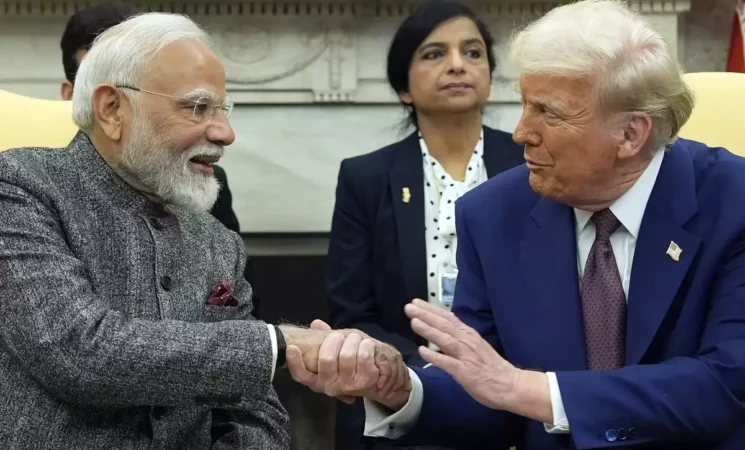30 June 2025, NIICE Commentary 11384
Samiksha Shewale
In a world increasingly characterized by economic uncertainty and geopolitical recalibration, international trade has become more than a commercial exchange it is now a strategic chessboard. At the center of the board stands the United States, once the loudest advocate of free trade, now gradually tilting towards protectionism. As tariff walls rise again, countries are forced to reassess their trade alignments, diplomatic strategies, and economic resilience. India, with its expanding global footprint and aspirations to become a manufacturing powerhouse, must now navigate the shifting sands of U.S. tariff policies with both caution and creativity.
The U.S. Protectionist Turn: A Changing Global Trade Climate
The roots of U.S. protectionism can be traced back to the Trump administration's "America First" policy, which ushered in a wave of tariffs against strategic adversaries, chiefly China. However, what began as a politically charged trade war has gradually evolved into a bipartisan consensus. Even under President Biden, the rhetoric has softened, but the core protectionist measures remain. In 2024, the Biden administration announced a tripling of tariffs on Chinese steel and aluminum, along with new levies on electric vehicles, semiconductors, solar cells, and critical minerals.
The justification? National security, unfair subsidies, intellectual property theft, and an urgent need to revitalize American manufacturing. While some of these claims are legitimate, the consequence has been a growing uncertainty in global trade flows and supply chains. Moreover, the idea of “friendshoring” trading primarily with allies, is gaining traction, slowly replacing the once-celebrated globalization narrative.
India’s Position: Strategic Alignment, Not Dependence
India, unlike China, is not the target of U.S. tariffs. The United States and India have been warming up economically, with bilateral trade hitting $128.6 billion in 2023, making the U.S. India’s largest trading partner. Yet, that doesn’t mean India is immune to the ripple effects of American trade nationalism.
Historically, India has had its own bouts of protectionism. Its reluctance to join RCEP (Regional Comprehensive Economic Partnership) was seen by many as a defensive move to protect domestic industries. However, under the Modi government’s Atmanirbhar Bharat (Self-Reliant India) campaign, there’s been a subtle shift from protectionism to strategic autonomy. India wants to engage with global markets but on its own terms.
Recalibrating the Trade Compass: Three Strategic Pathways
India now faces a pivotal moment. With U.S. tariff policies becoming unpredictable, it must craft a trade strategy that balances opportunity and self-interest. Here are three major directions India can consider:
- Deepening Bilateral Trade and Tech Diplomacy with the U.S.
India should leverage its growing geopolitical alignment with the U.S. to push for trade normalization in sensitive sectors. The termination of India’s GSP (Generalized System of Preferences) in 2019, which impacted over $6 billion worth of exports, still lingers. While India absorbed the blow, restoring these preferences or negotiating new sectoral deals could be a win-win.
Further, the launch of the U.S.-India Initiative on Critical and Emerging Technology (iCET) is a landmark step. It signifies an intention to co-develop technologies like AI, quantum computing, 5G/6G, and semiconductors. India should build on this by securing tariff exemptions or preferential access for high-tech goods produced under joint ventures. Simultaneously, India must ensure that digital trade issues especially the U.S. stance against India’s digital services tax are resolved through negotiation, not retaliation.
- Harnessing the Indo-Pacific Economic Framework (IPEF) Strategically
India’s participation in IPEF, launched by President Biden in 2022, reflects its interest in shaping regional trade norms without formally joining multilateral free trade agreements. IPEF is different from typical FTAs—it focuses on digital trade, clean energy, resilient supply chains, and tax transparency rather than tariffs.
This is advantageous for India. By actively engaging in IPEF’s Supply Chain Resilience Pillar, India can position itself as a trusted alternative to China in key sectors such as pharmaceuticals, semiconductors, and rare earth processing. Already, U.S. firms are looking at India for China+1 diversification. With smart incentives and policy clarity, India can transform these intentions into investments. However, India has chosen not to join the IPEF trade pillar due to concerns about labor, environmental, and digital commitments. This is understandable, but over time, India must find a way to engage constructively perhaps through selective convergence rather than complete alignment.
- Securing WTO Rules and Reviving the Multilateral Trade Order
As the U.S. leans further into unilateral tariff measures, India must become a champion of multilateralism. It should play a more assertive role in reviving the World Trade Organization’s (WTO) dispute resolution mechanism, which the U.S. has effectively paralyzed. India, alongside the EU and other middle powers, can push for reforms that ensure countries are not able to impose arbitrary tariffs under the vague pretext of national security. This is vital, as today’s protectionism could be tomorrow’s economic bullying. For India’s small and medium enterprises (SMEs), predictable and rules-based trade is not just desirable, it is essential. Moreover, India’s success at the WTO ministerial in Geneva (2022), where it negotiated effectively on fisheries, food security, and vaccine waivers, proves it has the diplomatic acumen to steer global trade dialogue.
The Manufacturing Moment: India’s Window of Opportunity
Protectionism in the U.S. creates short-term disruptions but also long-term opportunities. As American firms seek to reduce dependence on Chinese manufacturing, India can position itself as the preferred production hub for goods ranging from textiles and electronics to solar panels and defense equipment. The Production-Linked Incentive (PLI) schemes launched by the Indian government are timely. Several U.S. companies, including Apple, Tesla, and Micron, have either started or shown interest in expanding operations in India. The government must ensure that red tape, regulatory unpredictability, and infrastructure bottlenecks do not derail this momentum. At the same time, India needs to protect itself. If U.S. tariffs on Chinese goods redirect dumped Chinese goods into Indian markets, domestic industries could be at risk. India’s trade policy must be agile enough to respond to such distortions.
Digital Trade: A Cautionary Tale
One of the most contentious emerging areas is digital trade. India’s emphasis on data localization and its now-defunct equalization levy have drawn criticism from the U.S. These disputes, if escalated, could trigger retaliatory tariffs under U.S. Section 301 provisions, as was threatened in 2021. India must articulate its digital sovereignty concerns clearly while working toward mutual recognition agreements with like-minded economies. The goal should be to protect national interests without isolating itself from global digital value chains.
The Road Ahead: Pragmatic Multilateralism with a National Core
India’s trade recalibration in response to U.S. tariff shifts must rest on a pragmatic mix of bilateralism, multilateralism, and strategic autonomy. It should engage the U.S. assertively but constructively, avoid dependence, and strengthen domestic capacities to absorb external shocks.
In the years ahead, the global economy may become more fractured, with spheres of influence replacing universal rules. In such a world, India’s trade compass must not be driven merely by ideology but by outcome-oriented engagement one that secures jobs, promotes innovation, and enhances sovereignty. Tariffs may rise and fall. Political winds may shift. But if India can build its trade strategy on resilience, responsiveness, and rules-based order, it can not only weather the U.S. protectionist storm—it can thrive beyond it.
Samiksha Shewale is currently pursuing her Master's in International Electoral Management and Practices at the Tata Institute of Social Science, Mumbai, India.

